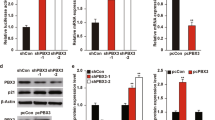Abstract
Restin, belonging to the melanoma-associated antigen superfamily, was firstly cloned from the differentiated HL-60 cells when induced by all-trans retinoic acid (ATRA) in our lab. Our previous results showed that restin might be correlated to cell cycle arrest. Due to the importance of p53 in the regulation of cell growth and the relationship between p53 and ATRA, we tried to test the relationship between p53 and restin. Firstly, transfection results showed that p53 was able to upregulate the expression of restin at the transcriptional level when p53 was transfected into eukaryotic cells. Secondly, the bioinformatics analysis revealed that the upstream sequence (about 2 kb) from the first ATG of the ORF of restin gene contained a p53 binding site. In order to confirm that p53 was involved in the transcriptional regulation of restin, we cloned the upstream sequence of restin and constructed the promoter luciferase reporter system. From the luciferase activity, we demonstrated that the promoter of restin gene could be induced by ATRA. Then, another two luciferase reporter plasmids driven by the reporter of restin with no (RPΔp53-luc) or mutant (mRP-luc) p53 binding site were constructed to see the regulation of restin by p53. Results showed that the transcriptional upregulation of restin gene was not due to the putative p53 binding site on the upstream of restin gene. We proposed that p53 upregulated restin transcription through an indirect way rather than direct interaction with the cis-activating element of the restin promoter.
Similar content being viewed by others
References
Chomez P, De Backer O, Bertrand M, et al. An overview of the MAGE gene family with the identification of all human members of the family. Cancer Res, 2001, 61: 5544–5551
Zhao Z L, Lu F, Zhu F, et al. Cloning and biological comparison of Restin, a novel member of Mage superfamily. Sci China Ser C-Life Sci, 2002, 45(4): 412–420
Taniura H, Taniguchi N, Hara M, et al. Necdin, a postmiotic neron-specific growth suppressor, interacts with viral transforming proteins and cellular transcription factor E2F1. J Biol Chem, 1998, 273: 720–728
Taniura H, Matsumoto K, Yoshikawa K. Physical and functional interactions of neuronal growth suppressor necdin with p53. J Biol Chem, 1999, 274: 16242–16248
Salehi A H, Roux P P, Kubu C J, et al. NRAGE, a novel MAGE protein, interacts with the p75 neurotrophin receptor and facilitates nerve growth factor-dependent apoptosis. Neuron, 2000, 27: 279–288
Zhu F, Yan W, Zhao Z L, et al. Related improved PCR-based subtractive hybridization strategy for cloning differentially expressed genes. Biotechniques, 2000, 29(2): 310–313
Yan W, Wang W L, Zhu F, et al. Cloning and subcellular localization of apr-1—A new gene of tumor specific antigen family. Ai Zheng, 2005, 24(2): 129–134
Wu Y S, Lu F, Qi Y X, et al. Interaction of Restin with transcription factors. Sci China Ser C-Life Sci, 2005, 48(3): 256–262
Zhang H, Rosdahl I. Expression profiles of p53, p21, bax and bcl-2 proteins in all-trans-retinoic acid treated primary and metastatic melanoma cells. Int J Oncol, 2004, 25(2): 303–308
Shiras A, Sengupta A, Shepal V. Cloning and tissue-specific gene expression studies with dlxin-1, a newly identified transcriptional activator. Mol Cell Biol Res Commun, 2001, (4): 313–319
Golubovskaya V, Kaur A, Cance W. Cloning and characterization of the promoter region of human focal adhesion kinase gene: nuclear factor kappa B and p53 binding sites. Biochim Biophys Acta, 2004, 1678: 111–125
Kim E, Albrechtsen N, Deppert W. DNA-conformation is an important determinant of sequence-specific DNA binding by tumor suppressor p53. Oncogene, 1997, 15(7): 857–869
Hecke, D, Page G, Lohrum M, et al. Complex regulation of the DNA-binding activity of p53 by phosphorylation: differential effects of individual phosphorylation sites on the interaction with different binding motifs. Oncogene, 1996, 12(5): 953–961
Townsend P A, Scarabelli T M, Davidson S M, et al. STAT-1 interacts with p53 to enhance DNA damage-induced apoptosis. J Biol Chem, 2004, 279(7): 5811–5820
Author information
Authors and Affiliations
Corresponding author
Additional information
Supported by the National Natural Science Foundation of China (Grant Nos. 30271457 and 30470874)
These authors contributed equally to this work
Rights and permissions
About this article
Cite this article
Wang, R., Lu, F., Fu, H. et al. Transcriptional upregulation of restin by p53. SCI CHINA SER C 50, 88–92 (2007). https://doi.org/10.1007/s11427-007-2039-0
Received:
Accepted:
Issue Date:
DOI: https://doi.org/10.1007/s11427-007-2039-0




